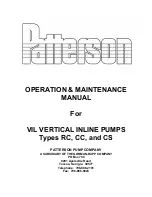
C L I M A T E M A S T E R W A T E R - S O U R C E H E A T P U M P S
38
C l i m a t e M a s t e r Wa t e r- S o u rc e H e a t P u m p s
Tr a n q u i l i t y 1 6 ( T C ) S e r i e s
R e v. : 2 5 J u l y, 2 0 1 7
for 5 seconds, “off” for 25 seconds, “on” for 5 seconds,
“off” for 25 seconds, etc.
UPS warning code = 8
Swapped FP1/FP2 thermistors: During test mode, the
control monitors to see if the FP1 and FP2 thermistors
are in the appropriate places. If the control is in test
mode, the control will lockout with code 9 after 30
seconds if:
a) The compressor is on in the cooling mode and the
FP1 sensor is colder than the FP2 sensor, or:
b) The compressor is on in the heating mode and the
FP2 sensor is colder than the FP1 sensor.
Swapped FP1/FP2 thermistor code = 9.
ESD (DXM only):
The ESD (Emergency Shut Down)
mode can be enabled from an external common signal
to terminal ESD to shut down the unit. The green status
light will fl ash code 3 when the unit is in ESD mode.
ESD mode = code 3 (green “status” LED)
Diagnostic Features -
The LED on the CXM board
advises the technician of the current status of the CXM
control. The LED can display either the current CXM
mode or the last fault in memory if in test mode. If
there is no fault in memory, the LED will fl ash Code 1
(when in test mode).
The green status LED and red fault LED on the DXM
board advise the technician of the current status of the
DXM control. The status LED will indicate the current
mode that the DXM control is in. The fault LED will
ALWAYS fl ash a code representing the LAST fault in
memory. If there is no fault in memory, the fault LED will
fl ash Code 1. The yellow test LED will turn on when in
test mode.
CAUTION: Do not restart units without
inspection and remedy of faulting condition. Damage
may occur.
CXM/DXM Control Start-up Operation - The control
will not operate until all inputs and safety controls are
checked for normal conditions. The compressor will
have a 5 minute anti-short cycle delay at power-up.
The fi rst time after power-up that there is a call for
compressor, the compressor will follow a 5 to 80 second
random start delay. After the random start delay and
anti-short cycle delay, the compressor relay will be
energized. On all subsequent compressor calls, the
random start delay is omitted.















































